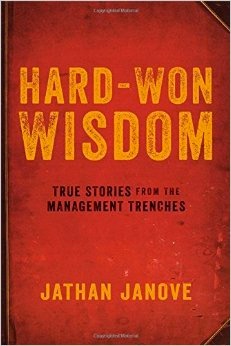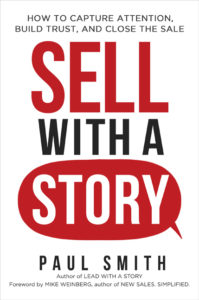Podcast: Play in new window | Download | Embed
Subscribe: RSS
Podcast (lead-with-a-story-podcast-series): Play in new window | Download | Embed
Subscribe: RSS
 My podcast guest this week is Jathan Janove, who stopped by to share three fascinating stories from his new book, Hard-Won Wisdom: True Stories from the Management Trenches.
My podcast guest this week is Jathan Janove, who stopped by to share three fascinating stories from his new book, Hard-Won Wisdom: True Stories from the Management Trenches.
Today, Jathan is an organizational consultant, management blogger, and contributor to HR Magazine. But he spent 25 years as an attorney litigating some fairly salacious workplace problems, which we’ll hear some of today.
Below is the text of one of the stories he shared from his new book. For the other two, you’ll need to listen to the podcast. But it’s worth it because they’re even more interesting than this one.
Hard-won Wisdom #1: The New Cadillac, The Fur Coat, and the Confidentiality Clause
In the mid-1980s, a company in the energy industry hired me to conduct a workplace investigation and report my findings to its board of directors. As a young lawyer, this was a first for me. I was excited.
Karen, an engineering assistant, had complained to human resources that she was the victim of gender-based pay discrimination and that her boss, George, the head of the engineering department, had retaliated against her.
Durning my investigation, I uncovered evidence that validated Karen’s claims. She had been working for the past two years as an engineering assistant earning $30,000 per year (in 1985 dollars). Yet, she performed work identical to that of four male employees, each of whom had the title engineer and earned $45,000 per annum.
George, who was known behind his back as Mr. Old School, explained during our interview that the pay disparity was “entirely justified.” “Look,” he said, “we’re paying her more than what she got at her previous job. Besides, those guys have families to support.”
(“Old School” should have been “Old, Old, School.”)
Karen alleged that before going to human resources, she had raised the pay issue with George, but he had not responded well. “George told me that if I knew what was good for me, I would keep my mouth shut. Two days after this conversation, he told me he had changed his mind about approving me for a professional certification program. He said he only did such things for ‘team players.'”
In my interview, George denied retaliating against Karen. However, his denial didn’t help his credibility. “That little lady should be happy to have the job she’s got,” he said.
(Let’s make that, “Old, Old, Old School”)
 At a meeting with the board of directors to discuss my findings, a consensus quickly emerged on the path forward. Step 1: Fire George . . . Step 2 was settling Karen’s claim. In exchange for a full release of claims, I negotiated the following deal: a) The company “promoted” her to the engineering position she’d been doing for two years, b) it increased her salary to the same rate paid her male coworkers, and c) it provided a lump-sum payment of $15,000 in recognition of past lost income.
At a meeting with the board of directors to discuss my findings, a consensus quickly emerged on the path forward. Step 1: Fire George . . . Step 2 was settling Karen’s claim. In exchange for a full release of claims, I negotiated the following deal: a) The company “promoted” her to the engineering position she’d been doing for two years, b) it increased her salary to the same rate paid her male coworkers, and c) it provided a lump-sum payment of $15,000 in recognition of past lost income.
As I explained to the board of directors, under applicable law, $15,000 represented a mere one-fourth of the double-damages lost-pay award Karen would likely receive if she sued, not to mention the other economic damages she’d likely receive. After hearing this, a board member said, “Let’s get this done! Heck, I’ll write the check myself!”
Under the circumstances, I had negotiated a terrific deal for my client and basked in the glow. “Thump, thump, thump,” went my ego. Unfortunately, however, a large dose of humility awaited me.
As is typical in settlement agreements, the one I drafted included a provision barring Karen from disclosing terms of the deal. Other employees were aware of her claim and that it had been resolved but didn’t know the details.
To the best of my knowledge, Karen kept her end of the bargain. However, soon after the deal was cut, she arrived at work in a brand new, fully loaded Cadillac. On a chilly winter morning, she stepped out of her new car in a new coat that extended from neck to ankles and for which many small furry creatures had probably given up their lives.
Co-workers rushed up to Karen. “What did the company give you?!” they cried. “Tell us!”
Karen dutifully replied, “I’m sorry but the company’s lawyer made me sign a paper that says I can’t tell you.”
Word of Karen’s “deal” spread like wildfire.
Over the next two years, I had the opportunity to learn what kind of speculation had gone on concerning how much money Karen supposedly received. The rumor mill had a high range — $600,000. (Mind you, we’re talking 1985 dollars.) It had a low range — a scant $300,000. That’s right, the lowest any employee thought Karen received to settle her claims was 20 times the actual amount.
How did I learn this information? Because over those next two years, I had to wade through nearly 40 new claims of employment discrimination filed by Karen’s co-workers.
Moral of the story:
When employees don’t know, they speculate. And for employers, their speculation is always worse than reality. I call this the Law of Employee Speculation, which arises whenever management fails to share information employees consider important. They fill in the blank with speculation. If management withholds good news, employees will assume it’s negative or at best neutral. If their news would be neutral, it will be assumed bad. If bad, it will be assumed catastrophic.
Setting aside the legal system for a moment, every management or organizational guru I’ve studied has criticized American management for doing a lousy job at sharing information with employees. Why is the problem so prevalent? Most managers intuitively tend to hold their cards close to the chest out of fear that too much employee knowledge could be dangerous. Yet, this fear becomes self-fulfilling. Employees not only fill in the blanks with something worse than what the manager is fearful to disclose, their trust and respect in management erodes.
Accordingly. . . the question should not be “Why share?” but “Why not share?”
Hard-won Wisdom #2 involves a one night stand, an embarrassing email, and a case of CBT (“Casual Ball Tapping”). To find out what that’s all about, press the play button above and skip to 13:24 in the podcast.
Hard-won Wisdom #3 involves a near miss at a bar fight and a conflict resolution technique Jathan calls “verbal aikido.” To hear that, skip to 30:56 in the podcast above.
I’m giving away two free copies of Jathan’s book new book, Hard Won Wisdom. If you’d like to win one of those, send me your most interesting and insightful work story to paul@leadwithastory.com. The best two stories win. And if they’re good enough, and you’re interested, I might even feature them in an upcoming podcast or book. I’ll leave the contest open for 2 weeks after this podcast first posts.
 Paul Smith is one of the world’s leading experts on business storytelling. He’s a keynote speaker, storytelling coach, and bestselling author of the books Lead with a Story, Parenting with a Story, and Sell with a Story.
Paul Smith is one of the world’s leading experts on business storytelling. He’s a keynote speaker, storytelling coach, and bestselling author of the books Lead with a Story, Parenting with a Story, and Sell with a Story.


 Connect with him via email here.
Connect with him via email here.
Follow him on Facebook, LinkedIn, Twitter, and Instagram.
Sign up for his newsletter here to get one new story a week delivered to your inbox.

